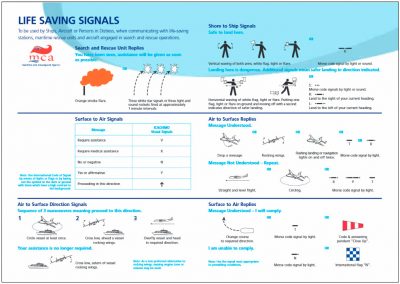On this page:
- Tripping Your Anchor
- Anchor Ball Day Signal
- Boat Handling in Rough Seas
- Search and Rescue Signals
- Towing and Being Towed
- Anchor Retrieval and the Alderney Ring
- Rules of the Road
- Doing the Prop Walk
- Ferryboat Glide
- Collision Course
- Beaufort Wind Scale
Tripping Your Anchor
There are so many lobster pot ropes, rocky patches and bits of stray wreckage in the Eastern Solent area that sooner or later you will get your anchor thoroughly snagged. Probably sooner. There is an easy way to make sure you don’t lose your anchor, by rigging it to “trip”. This involves shackling the chain to the “wrong” end of the anchor, and making a weak link connection to the “right” end of the anchor. The weak link can be a cable tie, or a few turns of cord. It needs to be strong enough to hold the full weight of the boat in normal anchoring conditions, but weak enough to break when there is additional strain.
There are two schools of thought on exactly where to place the weak link. Some prefer to have the chain tight along the stock, so the link only breaks by putting an angled strain on the anchor. This won’t help you if the anchor is caught round a pipe or rope, as it will be able to swivel. I prefer to leave a couple of links slack as in the photo. That way when the anchor is stuck, I can put the engine gently in reverse, and increase the revs bit by bit until the cord breaks, the anchor then swivels round and is pulled free.
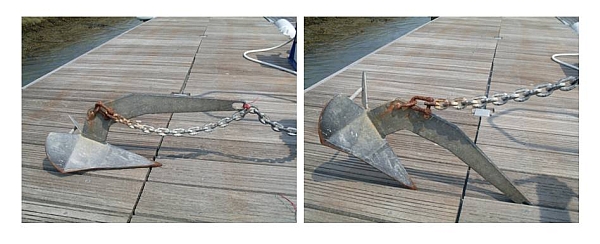
If you have to anchor in an emergency, you don’t want your anchor to break free at the wrong moment. In these circumstances put some extra ties on the link, or shackle it direct to the eye. This method of tripping is ideal for plough, bruce and fisherman anchors. It will not work reliably for Danforth style anchors because you cannot predict which way the flukes will set, and it can lie over the chain.
Anchor Ball Day Signal
All vessels are supposed to show a Day Signal of a single black ball suspended from a mast at the forward part of the vessel. In a yacht this is easy, on a motor boat a ball on a slick will do. You can buy folding anchor signal balls from any marine store. One problem is that they have a habit of folding shut. A simple hack to keep them open is to cut a short length of plastic pipe, then cut two pairs of slots at 90 degrees. Slot this pipe over the signal disks at the top, before you hang it from the mast. A picture helps here:
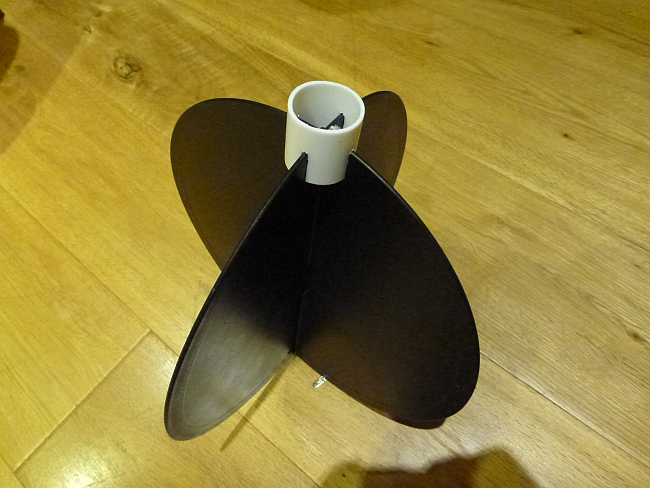
Boat Handling in Rough Seas
A good instructional video from the Gale Force Twins. This is particularly useful for anyone coming into Langstone Harbour entrance, which can get quite rough when a strong ebb flow meets southerly winds.
Search and Rescue Signals
I am sure most boat owners will be aware of distress signals, but how many are aware of the signals used to communicate with search and rescue boats and aircraft? If you were out wrecking and were involved in supporting a search, or if you were in difficulties yourself, this is vital knowledge. The Maritime and Coastguard Agency have a useful leaflet which can be laminated and kept on board. You can click on the image to print it.
Towing and Being Towed (Extract from “Angling Boats”)
You may need to be towed, or you may be in a position to offer another boat a tow, so some advice in this area will be useful. There are two ways of towing depending on the weather and the amount of manoeuvrability required: the traditional “pull”, or tying up alongside and traveling as one unit. The traditional tow suits any weather conditions and is the easiest, but does not offer much if any control of the towed boat. To prepare for a tow, make sure both parties know what is planned by discussing it on the radio. The anchor rope makes a good tow rope as it is strong and long – mooring warps are not usually long enough.
The towing points on both boats must be substantial – they will be put through significant stress so they must be securely fastened to a strong point in the boat. If you are worried about this, make a “cradle” by fastening a rope linking up several mooring points on the boat to spread the load or act as a backup in case the first point breaks. You can even put the rope right around the wheelhouse or cuddy, but be careful not to prevent doors from opening.
Once the tow has been passed, keep the line taught and in sight to prevent loose line sinking and fouling a propeller. The best approach is for the end of the rope to be secured to the towed boat first, then put a single turn of the rope around a cleat in the towing boat. As the boat moves ahead, let some line out and when there is a safe gap between the two boats, gradually increase the tension so they tow does not “snatch”. Let some more line slip out, take a second turn round the cleat then as the towed boat starts to follow you can secure the end. In very bad weather, if the rope is being jerked badly to the point where it may break or pull the tow points out, you can tie a heavy weight such as an anchor to the centre of the tow line to act as a shock absorber. This is easier said than done in heavy weather. Keep an eye on the towed boat and ensure the speed is not causing it to yaw from side to side – boats are designed to be pushed by a propeller and do not usually take kindly to being pulled from the front.
In very calm waters, and particularly if you want to take the towed boat alongside a jetty or pontoon, the two boats need to be tied together side by side. First put out plenty of fenders to prevent damage, then fasten two ropes to attach bow to bow and stern to stern, and another, substantial rope from the bow of the towing boat to the stern of the towed boat. This is the rope that will take most of the strain of the tow. Roped together like this, both boats can be manoeuvred as one, albeit rather clumsily, but at least you will be able to bring both alongside a pontoon even in a crowded harbour or marina.
Tip: The law of Salvage still applies today. If you accept help from another boat, and particularly if that help prevents the total loss of your boat, the rescuing boat can claim Salvage Rights equivalent to a significant proportion of the value of your boat. If possible when accepting help, agree terms before the rescue work starts. It is difficult to negotiate afterwards.
Anchor Retrieval and the Alderney Ring
(Extract from “Angling Boats”)
When you are ready to move to another mark or head back home, you will need to haul the anchor in. Firstly, remember to reel in all your lines, remove weights and secure hooks so they do not fly about. Put rods in rod holders or secure them with elastic cords out of the way. Start your engine, and let it warm up on tick-over while you sort out the anchor.
If the tide is slack and the anchor is light this may be simple enough if a little tedious – you can just haul it up. Keep the rope tidy, and don’t let the coils stray and tangle – if you suddenly let go of the anchor you don’t want to find yourself following it into the depths with a loop around your foot. Some boats have a purpose-built anchor rope locker, or you may coil your rope into a plastic bin. If the anchor locker is fiddly to stow rope in as you haul, fit a large hook such as a life-buoy holder on a rail nearby and loop the rope over the hook as you pull it in. This keeps it tidy until you can tuck it in the locker.
If the tide is running, you will be surprised how difficult it is to pull the anchor up by hand. One way is to have the helmsman motor very slowly up tide as a crew member pulls in the rope. This must be done very carefully to ensure the boat does not run over the rope and tangle the propeller. As the boat goes over the anchor and the rope is vertical to the sea-bed, the anchor will break out of its hold and the boat can be allowed to drift as the rest of the anchor rope is recovered.
Alternatively, if your wallet can stretch to it or the size of the boat justifies it you can fit an anchor winch. Manual winches may be adequate for yachts anchoring in shallow bays, but they are not really suitable for deep water anchoring. An electric winch is required, and these run to several hundreds of pounds, plus electrics and fitting costs.
Another method uses a large float and a stainless steel ring called an Alderney Ring. There is a branded version on the market called an Anka-Yanka. This method uses the force of the tide and the movement of the boat to lift the anchor, but it should only be used when you have plenty of boat handling experience because it is easy to make a mistake and tangle your propeller. However, when you feel ready for it here is how to do it.
You need a buoy, a large balloon fender or similar of sufficient size to float your entire anchor and chain. These are readily available from yacht chandlers, or cheaper ones can be bought from commercial fishing gear suppliers. You also require a large stainless steel ring of at least 15cm diameter, attached to the buoy with a shackle. To raise the anchor, you pass the anchor line through the ring and let the ring run freely up and down the anchor rope. Some rings are available with a gap and two smaller rings welded either side which makes it is easy to clip the ring to the rope without having to thread the rope through the ring. You could use a loop of rope or a large snap ring but these may not run as freely as a large steel ring.
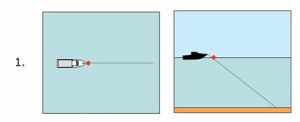
Throw the buoy into the water, then motor up-tide at an angle of about 30deg. to the direction of the anchor rope. As you motor forwards, the rope will slacken and make a loop, with the buoy slipping along the rope keeping the apex of the loop on the surface.
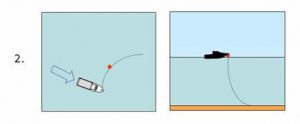
Keep your eyes on the buoy, and make sure you are not running over the anchor rope. If you lose sight of it, slip into neutral, drop back and try again. You may need to take a wider angle to clear the rope.
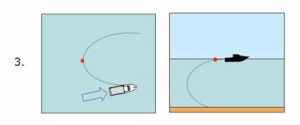
As you pass the point where the anchor is on the sea-bed, steer slightly back towards the original line of the anchor to follow a shallow arc around the anchor.
Keep going, and the anchor will be pulled up to the buoy.
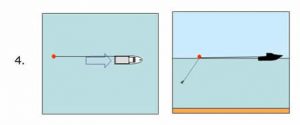
If the buoy sinks, it was too small! When you think the chain has reached the ring, give a burst of throttle to pull the chain through the ring, and put the engine in neutral. You can now pull the anchor back to the boat very easily, as the weight of anchor and chain is being carried by the buoy. Once you have recovered the rope, chain, buoy and anchor make everything secure – particularly the anchor, as you don’t want that to drop while you are traveling along. (Extracted from the chapter on Anchoring, in the book “Angling Boats” which you can order here.)
If you have problems with the method, check the Alderney Ring Troubleshooting page
Rules of the Road
Quite a few part-time skippers confess to being slightly unsure of the Rules of the Road. Most (but not all!) know which side to pass in a narrow channel but the crossing boats rule can be confusing. There is a simple way to remember – it is the same as a roundabout on a road! Give way to traffic coming from the right….
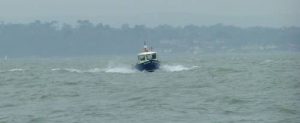
Vessel approaching head on: You turn to starboard to pass her Port side to Port side
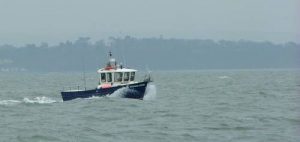
Vessel approaching from Port: They give way, you carry on
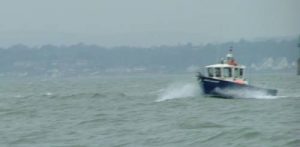
Vessel approaching from Starboard: You give way and pass to stern of her
Doing the Prop Walk
Propellers drive a boat forwards, but because a boat floats on water, there are some sideways movements that happen as well. This can be very useful when maneuvering in a tight space, as long as you know what will happen! Standard propellers rotate in one direction to move a boat forwards, and the other direction to move astern. The boat steers either by the flow of water over a rudder, or by pointing the whole drive leg as in outboards and out-drives. The rotation of the propeller “walks” the stern sideways very slightly as it rotates. This is more noticeable at low speeds when you put on a burst of throttle either forward or back – you will notice the stern move if you look. The effect is greater from large, slow-moving propellers.
To find out which way your stern will go when you want to use this effect, tie up to a secure berth, put the helm straight fore and aft, and with the engine running at tick-over put it in gear astern. You will see the water being driven out more on one side of the boat than the other. You can use this effect as follows. If the water was coming out on the starboard side, you know that by coming into a berth and putting the engine astern, the stern will swing to the port. If the berth is on your port side, your stern will swing in neatly. If it is on your starboard side, the stern will swing away from the berth, so you will need to turn the wheel to starboard to compensate.
To turn in a tight space, turn the helm hard to port and give a blip of throttle astern. Turn the help hard to starboard and give a blip of throttle ahead. Keep doing this and the boat will rotate almost in its own length – great for marinas! The one exception to this is duo-props, which have two contra-rotating propellers and have no prop-walk effect.
Ferryboat Glide
If you are coming alongside a pontoon when the tide is exceptionally strong and there is little room for error on the pontoon, such as if there are other boats moored ahead and astern of your chosen spot, motor gently up heading into the current, approaching your mooring position by steering close but perfectly parallel to the pontoon. When you are exactly opposite your berth, reduce the engine throttle so that you only just have enough forward momentum to remain stationery, held there by the current. By moving your wheel fractionally towards the pontoon you will be able to move sideways into your berth. Be ready to reduce speed further as you move between other boats as the current is likely to be weaker at that point. You can use the same method for coming up to a mooring buoy – align yourself alongside it then just slide the boat sideways to allow someone to catch it from the bows.
Collision Course
If a vessel is approaching at an angle, you may wonder whether it will pass clear or not. An easy way to check is to watch the bearing between the two boats. If the other vessel appears to be in the same place on your windscreen for a while, it is on the same bearing and you are on a collision course. This method works regardless of angle or speed. If the other vessel is moving across your windscreen in any direction, you will not collide as long as both vessels maintain speed and course.
